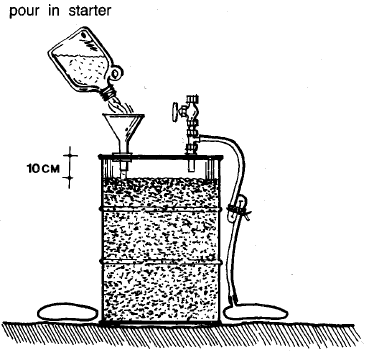|
|
|
||||
|
|
|
||||
| DETAILS |
How big should your biogas unit be?How to build a small biogas unit You will need
|
 |
Now clean both drums well inside and outside to remove oil and grease. If either drum has a hole in the side, close it tightly. This can be done with a metal plug or by welding a piece of metal in the hole as shown in the drawings.
|
 |
Straw which is mixed with manure, which you may have where you keep your pigs or chickens, is usually a good mixture of animal manure and plant material for making biogas. Be careful to chop it fine before you use it. When you first begin, it is best to use only animal manure or a mixture of animal manure and very little plant material.
|
|
Later when you have learned more about how your biogas unit works, you can use more plant materials. When you do begin to use plant materials, remember that dry plant materials must be chopped or shredded very fine and fresh plant materials must be left outside to rot for 10 days or more before you put them into a biogas unit.
|
How to use them
Making a starter
Putting waste into your biogas unit
 |
You can tell that the waste mixture in your simple biogas unit has begun to rot and make gas when the small drum begins to rise. This means that gas is being collected. If you find that gas is leaking from the small drum after the biogas unit has begun to work, seal the leaks with tar, mastic or paint. If the gas is leaking around the gas outlet or valve, tighten the outlet or valve again and coat the joints with tar, mastic or paint. A good way to check for leaks after the biogas unit has begun to work is to put soapy water on the small drum and on the joints of all the parts and lines. If you see bubbles anywhere, you will know that there is a leak.
|
 |
The best way to use the biogas that you make with your small biogas unit is for cooking. When your unit is working well, it will make enough gas every day to cook your evening meal. You can use biogas with almost any ordinary gas-burner, if you adjust the burner so that the right amount of air is mixed with the biogas. If there is too much air, the flame will be blown out and the biogas will not burn. If there is not enough air, the flame will be yellow, the biogas will not burn well and will not give enough heat.
|
 
Biogas is produced best at a temperature between 32 and 37°C. You will need oil drums, pipe, valves, a gas line and sealing materials to build a biogas unit.
|
  Again put three buckets of waste and three buckets of water in the large container and mix it as before. Pour this mixture into the drum. Then take out the funnel. Put a pole long enough to reach the bottom of the drum into the waste hole and stir all the mixture well. Continue in this way until the waste in the drum is about 10 centimetres from the top. Now put in about 4 litres of starter and stir it well. The starter, which has already begun to work, will help you to make gas sooner.
|
 |
|
Biogas 1 & 2 |